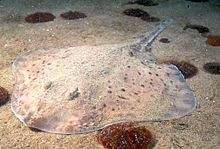Rajiformes
| Rajiformes Temporal range: middle Eocene–Recent PreЄ Є O S D C P T J K Pg N | |
|---|---|
 | |
Little skate (Leucoraja erinacea) | |
Scientific classification | |
| Kingdom: | Animalia |
| Phylum: | Chordata |
| Class: | Chondrichthyes |
| Superorder: | Batoidea |
| Order: | Rajiformes L. S. Berg, 1940 |
Rajiformes is one of the four orders in the superorder Batoidea, flattened cartilaginous fishes related to sharks. Rajiforms are distinguished by the presence of greatly enlarged pectoral fins, which reach as far forward as the sides of the head, with a generally flattened body. The undulatory pectoral fin motion diagnostic to this taxon is known as rajiform locomotion. The eyes and spiracles are located on the upper surface of the head and the gill slits are on the underside of the body. Most species give birth to live young, although some lay eggs with a horny capsule ("mermaid's purse").
Contents
1 Characteristics
2 Distribution
3 Diversity
3.1 Families
4 Biology
5 References
Characteristics
Rajoids typically have a dorsoventrally flattened body. The snout is slender and pointed and the wide mouth, often covered with a fleshy nasal flap, is on the underside of the head. The eyes and well-developed spiracles are located on the top of the head. In most species, the spiracles are large and are the main means of drawing water in for respiration. There is no nictitating membrane and the cornea is continuous with the skin surrounding the eyes. The gill slits are on the ventral surface just behind the head and there are five in all species except the sixgill stingray (Hexatrygon bickelli).[1] The front few vertebrae are fused into a synarcual and this either articulates with the bones of the well-developed pectoral girdle or is fused to them, the suprascapulae uniting above the vertebral column.[2] Most species have enlarged, thorn-like dermal denticles on their skin, often with a row of large denticles along the spine.[1]
The pectoral fins are large, but not clearly demarcated from the body, and together with the body are known as the disc. They start from the side of the head in front of the gill openings and end at the caudal peduncle. There are up to two dorsal fins but no anal fin. A slender tail is clearly demarcated from the disc. The caudal fin varies in size between species and the rays have a whip-like tail with no caudal fin.[1]
Distribution
Species of the order Rajiformes are found throughout the world's oceans, from Arctic to Antarctic waters, and from shallow coastal shelves to open seas and abyssal regions. A few are found in rivers and some in estuaries, but most are marine, living near the sea bed at depths down to 3,000 m (9,800 ft) or more.[1]
Diversity
Families
Four families of rajoid are currently recognized:[3][4]
- Anacanthobatidae
- Arhynchobatidae
- Gurgesiellidae
- Rajidae
Formerly, some Rhinopristiforms were also included.
The smooth skates, the Anacanthobatidae, contain a single genus, Anacanthobatis, of about 10 species. They are small fish living on the continental slopes of tropical and subtropical waters, and are native to Natal, South Africa, tropical West Africa, and Taiwan. Smooth skates have a filament extending from a rounded protuberance on the snout. Both the dorsal and ventral surfaces are smooth and have no dermal denticles. The tail is slender and a little shorter than the body. No dorsal fins are present and the caudal fin is small and membranous.[5]

Raja texana, the roundel skate
The skate family Rajidae contains 14 genera and around 200 species. They are found worldwide, but are relatively uncommon near coral reefs and in shallow tropical seas. A few species occur in brackish water. The disc shape is rhomboidal, and the tail long. Two dorsal fins are found and the caudal fin is much reduced. The pelvic fins have two lobes. Most species have rough skins with dermal denticles which are especially obvious along the spine. The eggs are laid in a protective hard case with string-like elongations at the four corners.[6]
Biology
In most rajoids, water for breathing is taken in through the spiracles rather than through the mouth and exits through the gill slits. Most species swim by undulating their enlarged pectoral fins, but the guitarfish propel themselves through the water with sideways movements of their tail and caudal fin. Most species are carnivores, feeding on molluscs and other invertebrates on the sea bed, and small fish, but the manta ray feeds on plankton sieved out of the water as it swims by its wide open mouth. Some species are viviparous, others ovoviviparous (both giving birth to live young), but the skates lay eggs in horny cases known as mermaid's purses. Most species are benthic, resting on the sandy or muddy sea bed, sometimes undulating their pectoral fins to stir up sediment and bury themselves shallowly. Others, like the manta ray, are pelagic, and continually cruise the ocean.[1]
References
| Wikimedia Commons has media related to Rajiformes. |
^ abcde Martin, R. Aidan. "Batoids: Order Rajiformes". ReefQuest Centre for Shark Research. Retrieved 2013-09-01..mw-parser-output cite.citationfont-style:inherit.mw-parser-output .citation qquotes:"""""""'""'".mw-parser-output .citation .cs1-lock-free abackground:url("//upload.wikimedia.org/wikipedia/commons/thumb/6/65/Lock-green.svg/9px-Lock-green.svg.png")no-repeat;background-position:right .1em center.mw-parser-output .citation .cs1-lock-limited a,.mw-parser-output .citation .cs1-lock-registration abackground:url("//upload.wikimedia.org/wikipedia/commons/thumb/d/d6/Lock-gray-alt-2.svg/9px-Lock-gray-alt-2.svg.png")no-repeat;background-position:right .1em center.mw-parser-output .citation .cs1-lock-subscription abackground:url("//upload.wikimedia.org/wikipedia/commons/thumb/a/aa/Lock-red-alt-2.svg/9px-Lock-red-alt-2.svg.png")no-repeat;background-position:right .1em center.mw-parser-output .cs1-subscription,.mw-parser-output .cs1-registrationcolor:#555.mw-parser-output .cs1-subscription span,.mw-parser-output .cs1-registration spanborder-bottom:1px dotted;cursor:help.mw-parser-output .cs1-ws-icon abackground:url("//upload.wikimedia.org/wikipedia/commons/thumb/4/4c/Wikisource-logo.svg/12px-Wikisource-logo.svg.png")no-repeat;background-position:right .1em center.mw-parser-output code.cs1-codecolor:inherit;background:inherit;border:inherit;padding:inherit.mw-parser-output .cs1-hidden-errordisplay:none;font-size:100%.mw-parser-output .cs1-visible-errorfont-size:100%.mw-parser-output .cs1-maintdisplay:none;color:#33aa33;margin-left:0.3em.mw-parser-output .cs1-subscription,.mw-parser-output .cs1-registration,.mw-parser-output .cs1-formatfont-size:95%.mw-parser-output .cs1-kern-left,.mw-parser-output .cs1-kern-wl-leftpadding-left:0.2em.mw-parser-output .cs1-kern-right,.mw-parser-output .cs1-kern-wl-rightpadding-right:0.2em
^ Johanson, Zerina; Trinajstic, Kate; Carr, Robert; Ritchie, Alex (2013). "Evolution and development of the synarcual in early vertebrates". Zoomorphology. 132 (1): 95–110. doi:10.1007/s00435-012-0169-9.
^ Vanden Berghe, Edward (2013). "Rajiformes". World Register of Marine Species. Retrieved 2013-08-16.
^ Last; White; de Carvalho; Séret; Stehmann; and Naylor, eds. (2016). Rays of the World. CSIRO. ISBN 9780643109148.CS1 maint: Uses editors parameter (link)
^ "Family Anacanthobatidae - Smooth skates". FishBase. Froese, Rainer; Pauly, Daniel (eds.). 2011. Retrieved 2013-08-15.
^ "Family Rajidae - Skates". FishBase. Froese, Rainer; Pauly, Daniel (eds.). 2011. Retrieved 2013-08-15.
